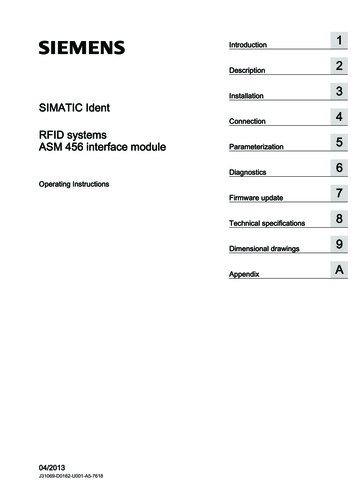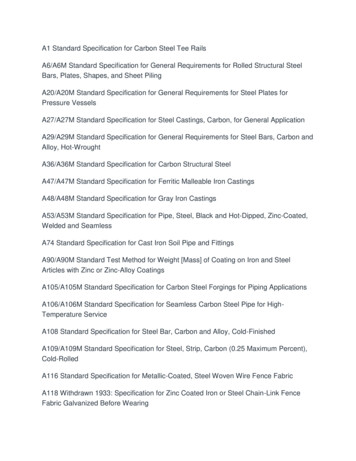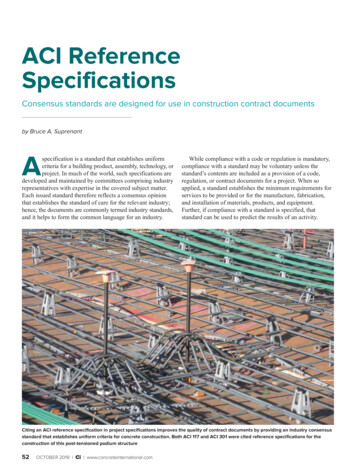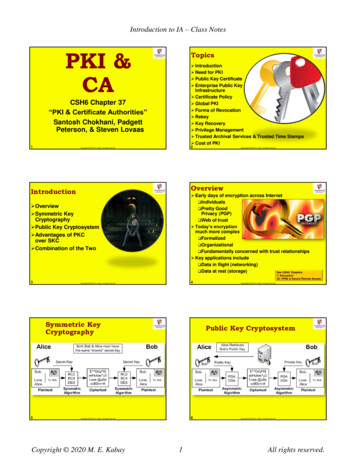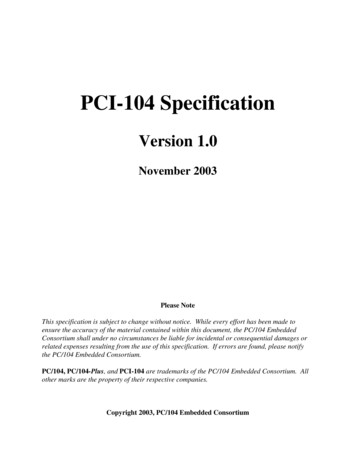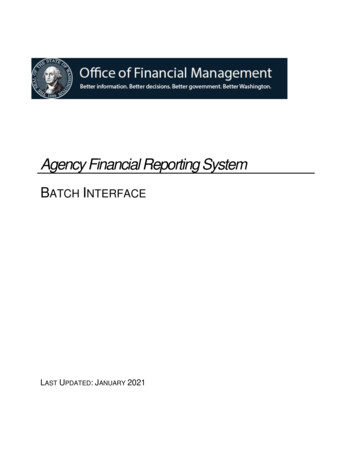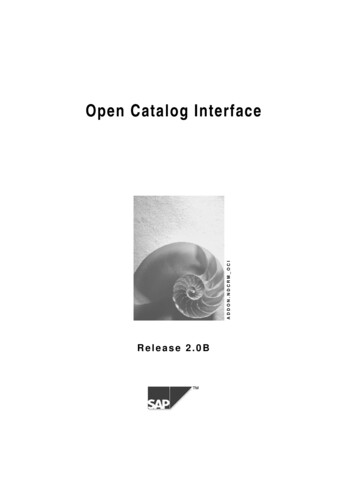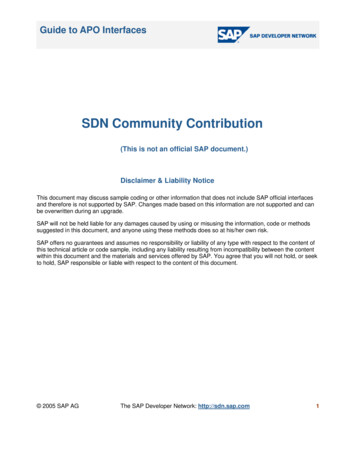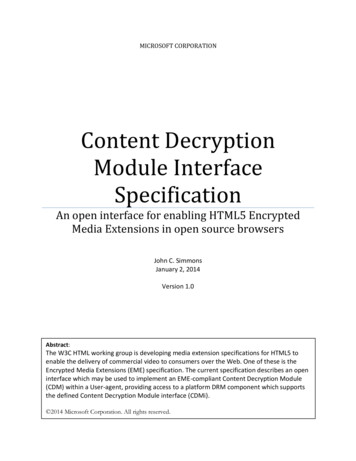
Transcription
MICROSOFT CORPORATIONContent DecryptionModule InterfaceSpecificationAn open interface for enabling HTML5 EncryptedMedia Extensions in open source browsersJohn C. SimmonsJanuary 2, 2014Version 1.0Abstract:The W3C HTML working group is developing media extension specifications for HTML5 toenable the delivery of commercial video to consumers over the Web. One of these is theEncrypted Media Extensions (EME) specification. The current specification describes an openinterface which may be used to implement an EME-compliant Content Decryption Module(CDM) within a User-agent, providing access to a platform DRM component which supportsthe defined Content Decryption Module interface (CDMi). 2014 Microsoft Corporation. All rights reserved.
Legal Notice 2014 Microsoft Corporation. All rights reserved. This document is provided "as-is." The Informationcontained in this document, including URL and other Internet Web site references, may change withoutnotice. You bear the risk of using it.This document does not provide you with any legal rights to any intellectual property in any Microsoftproduct. You may copy and use this document for your internal, reference purposes. You may notremove any notices from this document.2-Jan-14/1.0 2014 Microsoft Corporation. All rights reserved.i
Contents1Introduction . 11.11.21.31.41.52Scope . 1Conventions . 1Terminology, Abbreviations and Acronyms . 2References . 4Revision History. 5Content Decryption Module Interface . 62.12.22.32.4Architecture . 6CDM Interface Object Model . 7Cdm MediaKeys Object . 8Cdm MediaKeySession Object . 9FiguresFigure 1 Content Decryption Module Interface Entity Relationship Diagram . 6Figure 2 CDM Interface Object Model . 7TablesTable 1 CDMi Implementation ReadyState . 92-Jan-14/1.0 2014 Microsoft Corporation. All rights reserved.ii
2-Jan-14/1.0 2014 Microsoft Corporation. All rights reserved.iii
CO N T E N T D E CRY P T I O N M O DU L EI N T E R FA C E S P E C I F I C A T I O NVERS ION 1.0JANUA RY 2, 20141INTRODUCTIONRecent standardization advances have significantly enhanced the interoperability of commercialWeb media services [DRM]. The W3C HTML Working Group is developing HTML MediaExtensions for the support of these services. As of the time of this writing, there are twoprinciple HTML Media Extensions under development – the Media Source Extensions [MSE] andthe Encrypted Media Extensions [EME]1.Microsoft has developed a generalized interface enabling open source browsers to supportEncrypted Media Extensions – the Content Decryption Module interface (CDMi).21.1 SCOPEAn open interface for accessing a platform DRM Content Decryption Module (CDM) which maybe used by a User-agent to expose CDM functionality as specified by the W3C HTML EncryptedMedia Extensions.1.2 CONVENTIONSThe key words “MUST”, “MUST NOT”, “REQUIRED”, “SHALL”, “SHALL NOT”, “SHOULD”,“SHOULD NOT”, “RECOMMENDED”, “MAY”, and “OPTIONAL” in this document are to beinterpreted as described in [RFC2119]. That is: “MUST”, “REQUIRED” and “SHALL” mean that the definition is an absolute requirementof the specification. “MUST NOT” and “SHALL NOT” mean that the definition is an absolute prohibition ofthe specification.There are two additional W3C specifications outside the media extensions activity which will become important forconsumer web distribution -“Web Cryptography API” and “Web Crypto Key Discovery”.2 Microsoft will make available to PlayReady licensees a CDMi Implementation designed to work with the PlayReadyDevice Porting Kit (Device PK).12-Jan-14/1.0 2014 Microsoft Corporation. All rights reserved.1
Content Decryption Module interface Specification1.3 “SHOULD” and “RECOMMENDED” mean that there may be valid reasons to ignore aparticular item, but the full implications must be understood and carefully weighedbefore choosing a different course. “SHOULD NOT” and “NOT RECOMMENDED” mean that there may be valid reasons whenthe particular behavior is acceptable, but the full implications should be understood andthe case carefully weighed before implementing any behavior described with this label. “MAY” and “OPTIONAL” means the item is truly optional.TERMINOLOGY, ABBREVIATIONS AND ACRONYMS1.3.1 TERMINOLOGYAppDataContent DecryptionModule (CDM)Application specific data which is passed in someapplications with the InitData when creating a Key Session.3Component of the User-agent which provides support forone or more Key Systems [EME].It is transparent to the Web application whether a CDM ispart of or separate from the User-agent.A User-agent can support multiple CDMs.Content DecryptionModule interface (CDMi)An open, interoperable interface enabling a User-agent toimplement CDM functionality as provided by a platformDRM.CDMi ImplementationDRM-specific software which exposes the CDM interface,providing a translation between EME methods and eventsto the equivalent functions of the underlying platform DRM.CDMi ImplementationLicense StoreOptional local License store maintained by the CDMiImplementation.Encrypted MediaExtensions (EME)An HTML Media Extensions specification which extends theHTMLMediaElement to enable playback of ProtectedResources.Globally UniqueIdentifier (GUID)A unique reference number, represented as a 32-characterhexadecimal string, and usually stored as a 128-bit value.The AppData field is not yet in the official EME specification but is implemented in IE11 and will be proposed byMicrosoft to the EME specification.32-Jan-14/1.0 2014 Microsoft Corporation. All rights reserved.2
Content Decryption Module interface SpecificationHTML Media ExtensionsA suite of specifications either proposed, underdevelopment or completed in the W3C HTML workinggroup providing added browser functionality forcommercial web video services; e.g. Media SourceExtensions [MSE] and Encrypted Media Extensions [EME].Initialization DataIn HTML EME, a generic term for container-specific datathat is used by CDMs to generate a Key Request [EME]message.KeyDecryption key provided in a DRM License.Key Request messageIn HTML EME, a generic term for the Key or Licenseacquisition message sent to the License Server on behalf ofthe CDM [EME].Key SessionInterchange between the JavaScript application and theCDMi Implementation for acquisition of the Key or Keysneeded to decrypt media. See Media Session.Key SystemIn EME, a generic term for a decryption mechanism and/orcontent protection provider [EME].Key System StringA reverse domain name identifying the Key System [EME].For example, the Microsoft PlayReady Key System String is“com.microsoft.playready”.keyadded eventAn HTML EME event indicating a Key has been added as theresult of an update call [EME].keyerror eventAn HTML EME event indicating an error has occurred in oneof the HTML EME methods or in the CDMi Implementation[EME].keymessage eventAn HTML EME event indicating a message has beengenerated, most likely one which must be sent to a LicenseServer [EME].LicenseA DRM data structure that includes policies and anencrypted content Key.License ServerA server which provides DRM Licenses to clients.Licensed ProductThe components of an implementation which are subject tothe DRM Provider Compliance and Robustness Rules.Media SessionThe interchange between the media engine and the CDMiImplementation for the decryption of media samples. Thisinterchange is DRM-specific, is subject to the DRM providercompliance and robustness rules, and is not documented inthis specification (see section 2.1, below).2-Jan-14/1.0 2014 Microsoft Corporation. All rights reserved.3
Content Decryption Module interface SpecificationMedia Source Extensions(MSE)An HTML Media Extensions specification which extends theHTMLMediaElement to facilitate use cases like adaptivestreaming and time shifted live streams.Protection SystemSpecific Header box(‘pssh’)In the ISO Base Media File Format, the Protection SystemSpecific Header box contains Initialization Data needed by aspecific content protection system to decrypt the mediacontent [ISOBFF].Session IDIn HTML EME, a session ID is an optional string ID used toassociate calls related to a Key/License lifetime, startingwith the Key Request message [EME]. See Key Session.Update(EME session method) provides the License Server responseof a keymessage to the CDM Key System [EME].User-agent (UA)The client software used by an End-user to access HTTPservers.1.3.2 ABBREVIATIONS AND ACRONYMSCDMContent Decryption Module1.4CDMiContent Decryption Module interfaceEMEEncrypted Media ExtensionsGUIDGlobally Unique IdentifierJSJavaScriptKIDKey IdentifierMSEMedia Source ExtensionsUAUser-agentREFERENCES1.4.1 NORMATIVE REFERENCES[EME]“Encrypted Media Extensions”, http://www.w3.org/TR/encryptedmedia/ (latest editors draft: L5 A vocabulary and associated APIs for HTML and XHTML”,editors draft, http://dev.w3.org/html5/spec[RFC2119]“Key words for use in RFCs to Indicate Requirement Levels”, S. Bradner,March 1997, http://www.ietf.org/rfc/rfc21192-Jan-14/1.0 2014 Microsoft Corporation. All rights reserved.4
Content Decryption Module interface Specification1.4.2 INFORMATIONAL REFERENCES[CENC]ISO/IEC 23001-7: 2011, “Information technology – MPEG systemstechnologies – Part 7: Common encryption in ISO base media fileformat files”.[CRYPTO]“Web Cryptography API”, http://www.w3.org/TR/WebCryptoAPI[DASH]ISO/IEC 23009-1:2012, “Information technology — Dynamic adaptivestreaming over HTTP (DASH) — Part 1: Media presentation descriptionand segment vailableStandards/c057623 ISOIEC 23009-1 2012.zip[DRM]“Interoperability, Digital Rights Management and the Web”, John C.Simmons, Microsoft Corp., Dr. Stefan Arbanowski, Fraunhofer FOKUSResearch Institute, FF]ISO/IEC 14496-12, Third Edition, “Information technology – Coding ofaudio-visual objects – Part 12: ISO Base Media File Format”, withCorrigendum 1:2008-12-01, Corrigendum 2:2009-05-01, Amendment1:2009-11-15 and Amendment 3:2011-08-17.[KEYDSC]“WebCrypto Key Discovery”, �Media Source Extensions”, http://www.w3.org/TR/media-source/1.5 REVISION HISTORYVersion 1.0Initial version2-Jan-20142-Jan-14/1.0 2014 Microsoft Corporation. All rights reserved.5
Content Decryption Module interface Specification2CONTENT DECRYPTION MODULE INTERFACEThe Content Decryption Module interface (CDMi) is an open, interoperable interface enabling aUser-agent to implement CDM functionality as provided by a platform DRM. This interface isexposed by a CDMi Implementation, providing a translation between HTML Encrypted MediaExtension (EME) methods and events to the equivalent functions of the underlying platformDRM.The CDMi object model parallels that of the MediaKeys and MediaKeySession objects in theW3C Encrypted Media Extensions specification [EME] and is intended to have no DRM-providerspecific elements.2.1 ARCHITECTUREThe relationship of the Content Decryption Module interface Implementation to the browser,the media engine and the underlying Platform DRM are shown in the Figure 1.Figure 1 Content Decryption Module Interface Entity Relationship DiagramThe CDMi Implementation is part of the DRM provider’s Licensed Product – i.e. subject to thecompliance and robustness rules of the DRM provider’s license agreement. It is this softwarewhich contains the actual CDM objects used for Key acquisition.The CDM MediaKeys and MediaKeySession objects in the browser are a remote procedure call‘projection’ from the CDMi Implementation, using a platform-specific RPC mechanism.2-Jan-14/1.0 2014 Microsoft Corporation. All rights reserved.6
Content Decryption Module interface SpecificationThe Content Decryption Module interface (CDMi) is a Microsoft published open interfacespecification; browsers can utilize this interface without being a Licensed Product.4A media engine performs the decoding of the protected audio or video elementary streamsoutside the browser. In practice, this can be secure, hardware assisted decoding. The interfacebetween the browser and the media engine is platform and chipset specific and outside thescope of this specification.The media engine uses an authenticated interface to establish a Media Session forcommunicate to the CDMI Implementation. This ensures that only a DRM Provider-trustedmedia engine MAY pass media samples to the CDMi Implementation for decryption. This MediaSession is DRM-specific, is not implemented by the User-agent, and is therefore notdocumented in this open interface specification.5The CDMi Implementation contains the actual CDM functionality, enabling the browser CDM toexpose the methods and events defined by the W3C Encrypted Media Extensions withoutcompromising content protection or requiring DRM-specific functionality to be implementedwithin the browser.2.2 CDM INTERFACE OBJECT MODELThe CDM Interface is an object modeled after the EME MediaKeys object. Figure 2 summarizesthe CDMi object model.Figure 2 CDM Interface Object ModelMicrosoft will provide to PlayReady licensees a CDMi Implementation on top of the PlayReady Device Porting Kit.For example, the PlayReady CDMi Implementation incorporates a Media Session interface, to be used by thePlayReady licensee in the platform to secure content decryption.452-Jan-14/1.0 2014 Microsoft Corporation. All rights reserved.7
Content Decryption Module interface Specification2.3 CDM MEDIAKEYS OBJECTThe Cdm MediaKeys(wchar t *keySystem) constructor MUST run the following steps:1. If the keySystem is null, an empty string, or not the keySystem identifier for thisspecific CDMi Implementation - fail.62.3.1ATTRIBUTE KEYSYSTEMThe Keysystem attribute is a wchar t * pointer to an identifier of the Key System being used [EME].72.3.2 CREATESESSION METHODCreates a CDM Key management session.Use: createSession( wchar t * type, const unsigned char *initData, constunsigned char *AppData)typeinitDataAppDataMIMETYPE of the media. This MAY be ignored.As defined in [EME].CDM specific data which is passed in some applications with the InitData. 8Algorithm1. The CDMi Implementation creates a new Cdm MediaKeySession object with a readystate of START2. The CDMi Implementation sets the Cdm MediaKeySession SessionId to a randomvalue – a base 64 encoded GUID.3. The InitData and AppData are parsed and the CDMi Implementation specific data isextracted from the InitData9.4. Initialize the DRM Key Session state. This action is CDMi Implementation specific.Even though Cdm Init is a CDMi Implementation specific call, it takes the keySystem parameter because the reversedomain name format is intended to handle versioning, as well.7 For the Microsoft PlayReady CDMi Implementation, this is “com.microsoft.playready”.8 The AppData field is not yet in the official EME specification but is implemented in IE11 and has been proposed byMicrosoft to the EME specification. It enables Application specific information to be carried securely with the licenserequest.9 For the ISO Base Media File Format, the CDMi Implementation specific information extracted from initData will be aProtection System Specific Header box [CENC].62-Jan-14/1.0 2014 Microsoft Corporation. All rights reserved.8
Content Decryption Module interface Specification2.3.3 ISTYPESUPPORTED METHODDetermines whether a media type is supported for decryption by the CDMi Implementation.BOOL IsTypeSupported(wchar t *Keysys, wchar t *type )KeysystypeIdentifier of the Key System being used [EME].Pointer to a string characterizing the MIMETYPE of themedia.Algorithm1. Return TRUE if Keysys string and type are both supported by the CDMiImplementation.2.4 CDM MEDIAKEYSESSION OBJECTKey management session object created by Cdm MediaKeys createSession method.2.4.1 ATTRIBUTE KEYSYSTEMThe Keysystem attribute is a wchar t * pointer to an identifier of the Key System being used[EME].2.4.2 ATTRIBUTE SESSIONIDA wchar t * pointer to a unique Key Session identifier.This CDMi Implementation creates a randomly generated unique session ID (based 64 encodedGUID). It is fixed for the session after it is generated.2.4.3 ATTRIBUTE READYSTATEAn enum indicating the readyState of the CDMi Implementation.enum ReadyState �,“error”};Table 1 CDMi Implementation ReadyStateEnumeration DescriptionstartIndicates the MediaKeySession has been created but has not yet generated akeymessage.pendingThe MediaKeySession has generated a keymessage to acquire a Key, but hasnot successfully received the Key.readyThe MediaKeySession has received a Key for decrypting the content.2-Jan-14/1.0 2014 Microsoft Corporation. All rights reserved.9
Content Decryption Module interface SpecificationEnumeration DescriptionclosedA closed event has been fired at the MediaKeySessionerrorAn error has occurred and the Key Session has failed.2.4.4 MEDIAKEYSESSION::RUN METHODOnce the media Key Session has been established, a Keymessage can be generated, if needed.Use: long MediaKeySession::Run(callback);callbackSession Callback object (see 2.4.7, below).Algorithm1. If the CDMi Implementation supports locally cached Licenses, and a License exists in theCDMi Implementation License Store which can be used with this Key Session:a. The CDMi Implementation will use the Session Callback object Keyreadymethod to notify the UA CDM that the Key is ready for us.2. Elsea. The CDMi Implementation will generate a License challenge to be sent to itsLicense Serverb. If successful:- The CDMi Implementation will use the Keymessage method to promptthe UA CDM to notify the JS application to issue a License Requestmessage to the specified License Server- The CDMi Key Session readyState is changed to PENDING.c. Else- The CDMi Implementation will use the Session Callback objectkeyerror method to notify the UA CDM of the error.2.4.5 UPDATE METHODThis method is called by the UA CDM to process a License response.Use: long Update(const unsigned char *key, unsigned long cb);keycbPointer to an array of bytes containing the response from the License Server.Count byteAlgorithm1. The CDMi Implementation process the response from the License Server.2-Jan-14/1.0 2014 Microsoft Corporation. All rights reserved.10
Content Decryption Module interface Specification2. If successful:a. The CDMi Implementation will use the Session Callback object keyreadymethod to inform the UA CDM that the Key has been added.3. Elsea. The CDMi Implementation will use the Session Callback object keyerrormethod to inform the UA CDM of the error.2.4.6 CLOSE METHODUsed by the UA CDM to close the CDMi Key Session.Use: void Close();Algorithm1. The CDMi Implementation closes the CDMi Key Session.2.4.7 SESSION CALLBACK OBJECTThe methods in the Callback object are provided by the UA CDM so that the CDMiImplementation can provide information needed for the [EME] keyready, keyerror andkeymessage events.2.4.7.1 KEYMESSAGE METHODThis is a message generated by the CDMi Implementation, passed to the UA CDM and exposedto the JS Application as a keymessage event. It is likely a message to be sent to the LicenseServer.Use: void Keymessage (unsigned int *mesg, unsigned long cbmesg, char*dest, unsigned long cbdest);mesgcbmesgdestcbdestPointer to an array of bytes containing the messageCount byte of messageURL to send the message.Count byte of destination.Algorithm1. The CDMi Implementation will use a DRM specific mechanism to construct the KeyMessage.2-Jan-14/1.0 2014 Microsoft Corporation. All rights reserved.11
Content Decryption Module interface Specification2.4.7.2 KEYREADY METHODThis method informs the UA CDM that the Key is ready for use, either because the CDMiImplementation found an appropriate License in the CDMi Implementation License Store (seeCreateSession method, above) or because the License was successfully received from theLicense Server (see Update method, above).Use: void Keyready();2.4.7.3 KEYERROR METHODThis method informs the UA CDM that an error has occurred in the CDMi Implementation withregards to the present Key Session.Use: void Keyerror (unsigned short error, unsigned long syserror)errorsyserror2-Jan-14/1.0The error valueThe system error value 2014 Microsoft Corporation. All rights reserved.12
Specification An open interface for enabling HTML5 Encrypted Media Extensions in open source browsers John C. Simmons January 2, 2014 Version 1.0 Encrypted Media Extensions (EME) specification. The current specification describes an open Abstract: The W3C HTML working group is developing med
